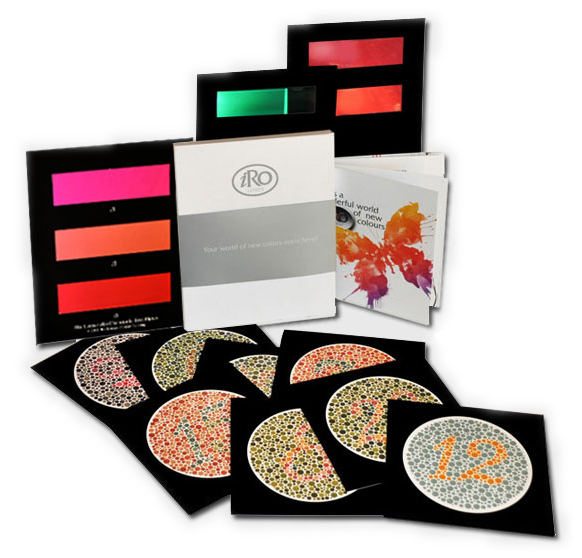Colour Blindness Experts
For so long, colour blind individuals have been told “nothing can be done”. But lenses to enhance colour vision are available right now and a simple test kit can even be ordered online through our website.
We are experienced optometrists with a special interest in colour vision in New Zealand, and we'd love to show you the difference colour correcting lenses can make. Book a colour vision assessment at For Eyes: in addition to the commonly used Ishihara book, we have colour blindness tests to diagnose the type and severity of your colour deficiency. We then select the best colour-correcting lens for you and re-test with it in place. You can trial the lenses in our clinic and outdoors before making the decision to purchase. We supply a range of frames to put the lenses into, including sunglass frames. Our colour-correcting lenses are 100% UV blocking, making them suitable to use as sunglasses.
Colour vision correcting lenses enable you to discriminate between more colours than you have ever been able to before. You will see a brighter, more varied world – more vivid sunsets, gardens and paintings – and more colours in the faces of people around you. You will be able to differentiate sports team colours (and match up your own outfits), and can safely complete small wiring jobs or follow colour-coded plans. Brian Currie (red-green colour blind) has experienced many positive changes since getting colour-correcting lenses from For Eyes Optometry Auckland. Read Brian's Story in Resene's Habitat magazine.
Many of our patients are amazed at the new colours they see, and describe the lenses as ‘life changing’ and ‘my best investment ever’.
What is Colour Blindness Like?
There are many different types of colour vision deficiencies that are labelled ‘colour blindness’. Most are due to genetic pigment variations in the cone cells of the retina (the cone cells are the cells that perceive colour and are responsible for much of our detail vision).
Genetic colour vision deficiencies are usually the red-green type and are far more common in males than in females. Certain shades of green-brown and orange-red look very similar, and colours that have red in them, like purple or mauve, look grey.
Examples of colour-confusion
- An engineer agreed to meet his colleagues on-site at a certain brown shed – but waited in vain at the green shed instead
- The art student who needs to ask his fellow students to pass the correct colour paints so he can avoid mix-ups
- The cricketer who took his eye off the red ball as it landed. His team and the crowd watched with amazement as he had trouble finding the ball hidden in the green grass
Simulation of Colour Deficient Vision
Click and drag the green bar in the centre of each image to simulate how person with colour deficiency might see the image.
Protonomaly severe red/green deficiency


Tritonomaly severe yellow/blue deficiency


Deuteranomaly trouble with red/green shades


The For Eyes Colour Vision Journey
After experiencing a colour blindness simulation at an optometry congress in 2007, Molly Whittington decided to specialise in colour blindness. "It made me realize how many of life’s everyday decisions and conversations revolve around colour," says Molly. "When I was introduced to the Colour Blind Sight Centres’ new lenses to correct colour vision deficiency, I was excited at the possibility of offering new colours to my colour deficient patients."
In 2008 For Eyes Optometrists Auckland became affiliates of Colour Blind Sight Centre and brought ColorView lenses to colour blind patients in New Zealand.
Since then For Eyes have helped many New Zealanders diagnose their colour blindness and see the world in a new and exciting way. Molly and Matthew, in conjunction with Colour Blind Sight Centres Australia, completed a study on the effectiveness of colour-correcting lenses which was presented by Molly at Te Papa in 2008.
Self-Assessment Post Out Kits
Now you can assess your own colour vision, and trial colour correcting lenses, without having to visit an optometrist. Order our post-out kit and see the difference these lenses make in your own environment before deciding to purchase colour correcting spectacles.
Choosing your Colour correcting lenses
When you are confident that the trial filters in the kit are suitable for your colour vision, you can order your new colour vision spectacle lenses from our shop, or via our website.
Or if you prefer to talk to a professional about your colour blindness and how colour correcting lenses can help you, come to our For Eyes Kumeu optometry clinic for a full assessment, and trial both the iRo and ColorView lenses.
The Importance of a Full Eye Examination
If you have not had a full eye examination in the last two years, we recommend you do so before purchasing ColorView or iRo lenses. This will determine whether your colour-correcting lenses require a prescription and if you have any other vision problems that need addressing.
Colour-correcting lenses can be made with magnetic frames to clip over normal spectacle lenses, so you can take them on and off and swap them between distance spectacles and reading glasses or can be made to any prescription as single vision, bifocal or progressive lenses.
How do the ColorView Lenses Work?
The ColorView lenses are the result of seven years of research and development by the World Munsell organisation. They work by altering the colour of light entering the eye to compensate for anomalous cone pigment at the retina.
The colour deficient retina interprets the true colour incorrectly; but if the true colour is altered with lenses, this altered colour is seen by the colour deficient retina the same way the true colour is by the normal retina. (Are you confused yet? No wonder it took them seven years to develop the lenses!)
All ColorView Lenses are 100% UV Blocking.
The new iRo lenses
After more research, Colour Blind Sight Centres Australia developed the new iRo series of lenses to better match the needs of the Australasian population. Here, we have a higher percentage of moderate to severe colour deficiency; while in Japan (where the ColorView lenses were developed) mild colour deficiency is more common. The iRo lenses are more tuned to the severe deficiencies.
All iRo Lenses are 100% UV blocking.
All ColourVision and iRo lenses are covered by our guarantee policy

